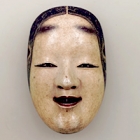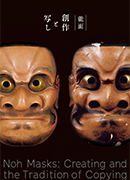Japanese Gallery (Honkan) Room 14
November 5, 2014 (Wed) - January 12, 2015 (Mon)
Noh was originally called "Sarugaku" and performed during rituals at Buddhist temples and Shinto shrines. For this reason, there are many old temples and shrines with Noh masks in their collections. During the Nanbokucho period (1333-1392), the "Four Great Sarugaku Troupes of Yamato (present-day Nara prefecture)" consisted of the Yuzaki (Kanze), Tobi (Hosho), Sakado (Kongo), and Enman'i (Konparu), all of which performed at Kasuga Shrine and Kofukuji Temple.
Kan'ami (1333-1384) and his son Ze'ami (c. 1363-c. 1443) from the Yuzaki troupe were favored by the powerful shogun Ashikaga Yoshimitsu (1358-1408), with Ze'ami successfully developing Noh into a performing art. Noh continued to be patronized by succeeding shoguns and eventually spread to the local feudal lords. It had become the official performing art for ceremonies held by the warrior class.
From the Nanbokucho (1333-1392) to the Muromachi (1392-1573) period, many new plays and masks were created. These masks are highly prized and brim with variety. From the Azuchi-Momoyama period (1573-1603), however, emphasis shifted to preserving plays from the preceding periods and copying classic masks. These copies faithfully reproduce not only the forms of the originals, but also the damage they had sustained, such as nicks and peeled paint. The Tokyo National Museum contains over 200 Noh masks, including very old ones passed down within the Konparu school. In addition to some of these pieces, ones from Negoroji Temple in Wakayama prefecture are also displayed. Both older, original masks as well as copies, such as the famous Yuki no Ko'omote, are featured. We invite visitors to explore how the forms of these originals and copies developed over the ages, while enjoying the subtle and profound aesthetics of Noh.


